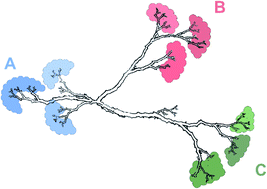当前位置:
X-MOL 学术
›
Chem. Sci.
›
论文详情
Our official English website, www.x-mol.net, welcomes your feedback! (Note: you will need to create a separate account there.)
Catalytic resonance theory: parallel reaction pathway control
Chemical Science ( IF 8.4 ) Pub Date : 2020/03/03 , DOI: 10.1039/c9sc06140a M. Alexander Ardagh 1, 2, 3, 4, 5 , Manish Shetty 1, 2, 3, 4 , Anatoliy Kuznetsov 1, 2, 3, 4 , Qi Zhang 1, 2, 3, 4 , Phillip Christopher 4, 5, 6, 7, 8 , Dionisios G. Vlachos 4, 5, 6, 7, 9 , Omar A. Abdelrahman 4, 5, 6, 7, 8 , Paul J. Dauenhauer 1, 2, 3, 4, 5
Chemical Science ( IF 8.4 ) Pub Date : 2020/03/03 , DOI: 10.1039/c9sc06140a M. Alexander Ardagh 1, 2, 3, 4, 5 , Manish Shetty 1, 2, 3, 4 , Anatoliy Kuznetsov 1, 2, 3, 4 , Qi Zhang 1, 2, 3, 4 , Phillip Christopher 4, 5, 6, 7, 8 , Dionisios G. Vlachos 4, 5, 6, 7, 9 , Omar A. Abdelrahman 4, 5, 6, 7, 8 , Paul J. Dauenhauer 1, 2, 3, 4, 5
Affiliation

|
Catalytic enhancement of chemical reactions via heterogeneous materials occurs through stabilization of transition states at designed active sites, but dramatically greater rate acceleration on that same active site can be achieved when the surface intermediates oscillate in binding energy. The applied oscillation amplitude and frequency can accelerate reactions orders of magnitude above the catalytic rates of static systems, provided the active site dynamics are tuned to the natural frequencies of the surface chemistry. In this work, differences in the characteristics of parallel reactions are exploited via selective application of active site dynamics (0 < ΔU < 1.0 eV amplitude, 10−6 < f < 104 Hz frequency) to control the extent of competing reactions occurring on the shared catalytic surface. Simulation of multiple parallel reaction systems with broad range of variation in chemical parameters revealed that parallel chemistries are highly tunable in selectivity between either pure product, even when specific products are not selectively produced under static conditions. Two mechanisms leading to dynamic selectivity control were identified: (i) surface thermodynamic control of one product species under strong binding conditions, or (ii) catalytic resonance of the kinetics of one reaction over the other. These dynamic parallel pathway control strategies applied to a host of simulated chemical conditions indicate significant potential for improving the catalytic performance of many important industrial chemical reactions beyond their existing static performance.
中文翻译:

催化共振理论:平行反应路径控制
通过稳定设计的活性位点上的过渡态,可以通过异质材料催化增强化学反应,但是当表面中间体以结合能振荡时,可以在同一活性位点上实现更大的速率加速。所施加的振荡幅度和频率可以将反应加速至比静态系统的催化速率高几个数量级,前提是将活性位动力学调整为表面化学的自然频率。在这项工作中,在平行反应的特性的差异被利用通过活性位点动力学的选择性应用(0 <Δ Ú <1.0 eV的振幅,10 -6 < ˚F <10 4Hz频率)以控制在共享催化表面上发生竞争反应的程度。对化学参数变化范围广的多个平行反应系统进行的仿真表明,即使在静态条件下没有选择性地生产特定的产物,平行化学在两种纯产物之间的选择性也是高度可调的。确定了导致动态选择性控制的两种机制:(i)一种产品在强结合条件下的表面热力学控制,或(ii)一种反应动力学相对于另一种动力学的催化共振。
更新日期:2020-04-01
中文翻译:

催化共振理论:平行反应路径控制
通过稳定设计的活性位点上的过渡态,可以通过异质材料催化增强化学反应,但是当表面中间体以结合能振荡时,可以在同一活性位点上实现更大的速率加速。所施加的振荡幅度和频率可以将反应加速至比静态系统的催化速率高几个数量级,前提是将活性位动力学调整为表面化学的自然频率。在这项工作中,在平行反应的特性的差异被利用通过活性位点动力学的选择性应用(0 <Δ Ú <1.0 eV的振幅,10 -6 < ˚F <10 4Hz频率)以控制在共享催化表面上发生竞争反应的程度。对化学参数变化范围广的多个平行反应系统进行的仿真表明,即使在静态条件下没有选择性地生产特定的产物,平行化学在两种纯产物之间的选择性也是高度可调的。确定了导致动态选择性控制的两种机制:(i)一种产品在强结合条件下的表面热力学控制,或(ii)一种反应动力学相对于另一种动力学的催化共振。



























 京公网安备 11010802027423号
京公网安备 11010802027423号